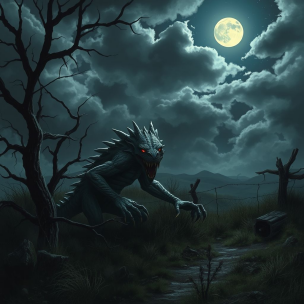
Chupacabra Sightings on the Rise: Unraveling the Enigma Behind the Mysterious Creature’s Resurgence
In recent months, a wave of bizarre sightings has been sweeping across the Americas, leaving residents and experts alike perplexed. The Chupacabra, a legendary creature said to drain the blood of livestock, has seemingly made a comeback, with numerous reported sightings popping up in Mexico, Puerto Rico, and the southern United States. But what’s driving the resurgence of this mysterious being, and is there any truth to the tales of its bloodthirsty exploits?
A Brief History of the Chupacabra
For those unfamiliar with the legend, the Chupacabra (Spanish for “goat-sucker”) first emerged in the 1990s in Puerto Rico. The creature was described as a strange, reptilian being with spines or quills on its back, a row of spines or spikes running down its neck, and a distinctive “V”-shaped cut on the top of its head. According to eyewitness accounts, the Chupacabra would attack and drain the blood of livestock, often leaving behind a trail of dead animals with puncture wounds in their necks.
Sightings on the Rise
Fast-forward to the present, and it appears the Chupacabra is back in business. In Mexico, multiple sightings have been reported in the states of Chihuahua and Sonora, with some witnesses claiming to have seen the creature attacking and killing sheep and goats. In Puerto Rico, where the legend originated, new sightings have been reported in the towns of Canóvanas and Loíza. Even in the southern United States, particularly in Texas and Arizona, there have been reports of Chupacabra sightings, although these are less frequent and often more anecdotal.
Theories and Explanations
So, what could be behind the sudden resurgence of Chupacabra sightings? While some believe the creature may be a genuine, unknown animal, others propose more rational explanations. One theory is that the Chupacabra is simply a modern-day manifestation of an ancient folklore, with the legend being passed down through generations and influencing the way people perceive and interpret strange events.
Another theory suggests that the Chupacabra may be a misidentified known animal, such as a coyote or a wild dog, that has been attacking livestock and leaving behind similar wounds. This theory is supported by the fact that many reported Chupacabra sightings can be explained by the presence of known predators in the area.
The Role of Social Media and Folklore
Social media has also played a significant role in the resurgence of Chupacabra sightings. The internet and social media platforms have created an echo chamber where stories and legends can spread quickly, often without being fact-checked or verified. This has led to a snowball effect, where more and more people become convinced of the Chupacabra’s existence, and the legend grows and evolves through a process of oral tradition.
Conclusion
While the Chupacabra remains a mysterious and intriguing figure, it’s essential to approach these sightings with a healthy dose of skepticism. Until concrete evidence emerges, it’s impossible to say for certain whether the creature is real or simply a product of folklore and misinformation. Nonetheless, the Chupacabra’s enduring presence in popular culture and the public imagination is a testament to the power of storytelling and the human fascination with the unknown.
As the sightings continue to roll in, one thing is certain – the Chupacabra has become an integral part of modern folklore, symbolizing the enduring human fascination with mystery, the unknown, and the darker aspects of nature. Whether or not the creature ultimately proves to be “real,” its impact on our collective imagination and cultural heritage is undeniable.
